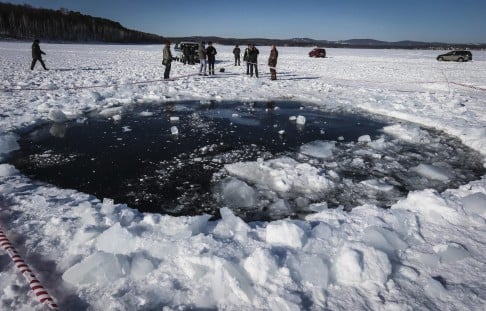
Asteroid explosion over Chelyabinsk, Russia, opens cosmic secrets
Scientists learn from last year's once-in-a-lifetime event over central Russia, with mobile phone and camera footage used to track its path
A year ago yesterday, inhabitants of the Russian city of Chelyabinsk looked skywards, some frozen in fear that a nuclear war had begun.

The shockwave blew out windows, hurting about 1,600 people, and the burst of ultraviolet light was so strong that more than two dozen people suffered skin burns.
Today enshrined in Russia's folk memory as a big scare, the Chelyabinsk Meteorite, for space scientists, is a boon.
They say it has yielded unprecedented insights into the make-up and orbit of asteroids and the risks that a rogue rock may pose to earth.
"It was a remarkable event," said Mark Bailey, director of the Armagh Observatory in Northern Ireland.
Only a few asteroids ever cross earth's path. Fewer still survive the fiery contest of friction with the atmosphere. Those that do are likely to fall in the sea, which covers more than two-thirds of the planet, or in a remote area, such as desert, tundra or Antarctica.

The event "has provided colossal information", said Viktor Grokhovsky of the Russian Academy of Sciences.
"Thanks in particular to the video recordings, Chelyabinsk is one of only 18 meteorites where it has been possible to make a backwards calculation of its trajectory, to find where it came from in the asteroid belt," he told the paper .
Its age was calculated at 4.5 billion years, the same as that of the solar system - meaning it consisted of primordial matter.
Digging into this treasure trove of evidence, scientists estimate the asteroid must have measured about 20 metres across and weighed some 13,000 tonnes.
As it entered the earth's atmosphere, that mass would have translated into the energy equivalent of half a million tonnes of TNT, or 30 times the yield of the Hiroshima bomb.
"The asteroid broke into small pieces between the altitudes of around 45 and 30 kilometres, preventing more serious damage on the ground," scientists in the Czech Republic and Canada reported last November.
The trajectory, they added, suggested it was once part of a massive two-kilometre rock called 86039, a nasty "geocruiser" first spotted in 1999 that regularly comes close to earth's orbit.
Meteorite hunters have gone into overdrive to pick up fragments, including a mighty half-tonne chunk recovered from a lake near Chelyabinsk.
Chemical analysis revealed the meteorite was a so-called LL chondrite, which constitutes a minority of asteroids, but with a high content of cobalt.
Grokhovsky said the fragments had intriguing differences. Some are blackened on top, others all the way through and others are half-and-half.
Maybe it is radiation from space, the impact, the melting
"Maybe it is radiation from space, the impact, the melting," he said.
Investigators will meet in Houston in the US state of Texas from March 17 to 21 at the annual Lunar and Planetary Science Conference, which is devoting a special session to the Chelyabinsk event.
The last time that a big rock is known to have collided with earth was on June 30, 1908, when an object up to 70 metres across exploded over Tunguska, Siberia, flattening 80 million trees over 2,000 square kilometres.
The Tunguska and Chelyabinsk asteroids belong in the lower ranks of the medium category of asteroid risk, say astrophysicists.
Asteroids in the middle category can inflict local and, at the top end of the scale, regional damage.
But they are too small to belong to the class of civilisation wipers - monsters more than a kilometre across, capable of inflicting a mass extinction.
This is likely what happened 65 million years ago, when the long reign of the dinosaurs was ended by climate change thought to have been brought on by an impact in the Yucatan peninsula in modern-day Mexico.
The unsettling news, though, is that the risk from Tunguska-sized objects may have to be reviewed in the light of what happened at Chelyabinsk.
"Rather than running into earth at an interval of around 4,500 years, as conventional wisdom has it, Tunguska-sized objects appear to be coming in to hit the earth maybe every several hundred years," said Bailey.
"That's quite a lot more often."
